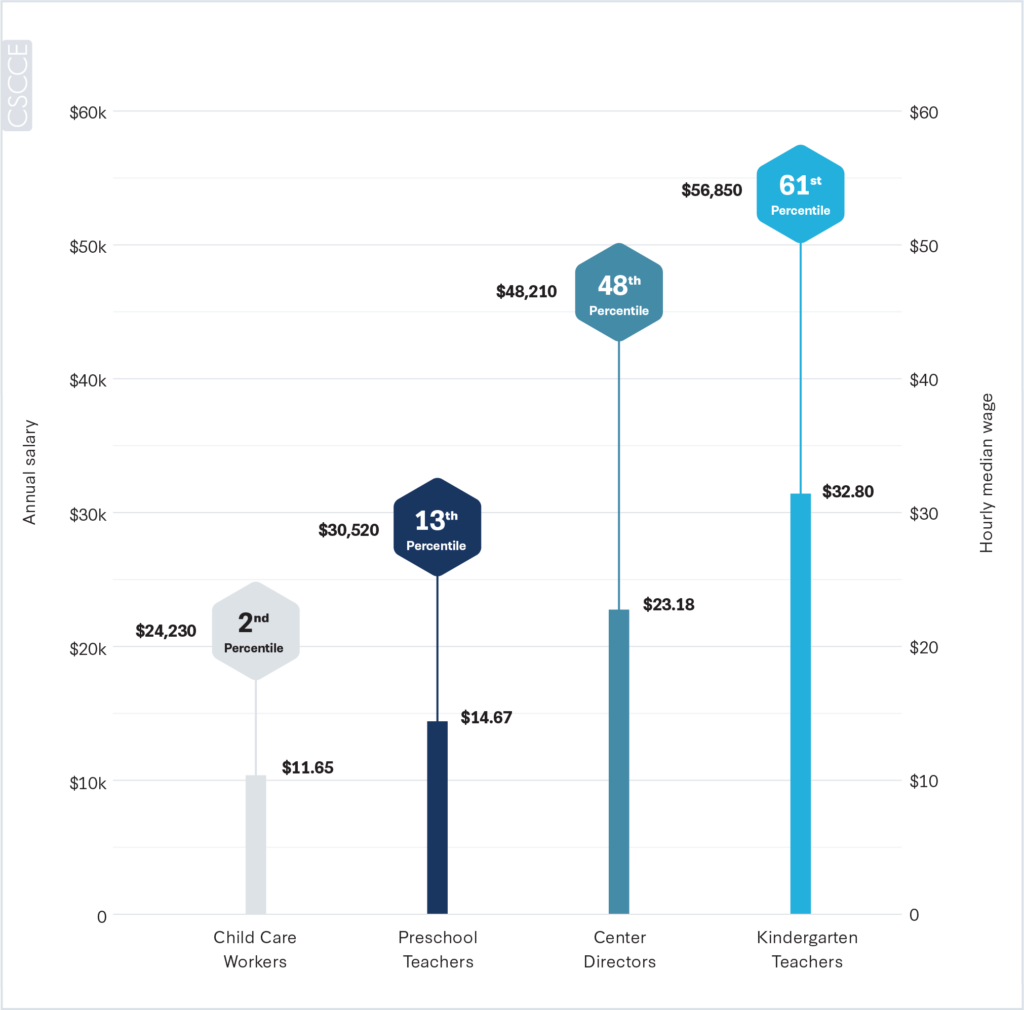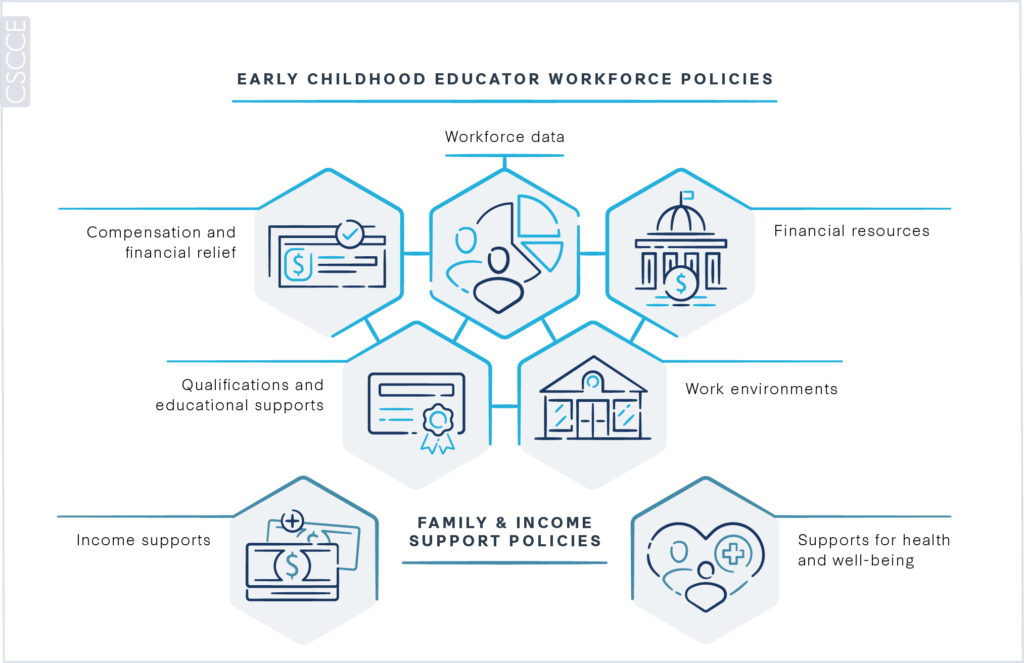Key Findings
Download Introduction & Policy RecommendationsThe existing early care and education (ECE) system does a disservice to the educators — largely women and often women of color — who nurture and facilitate learning for millions of the nation’s youngest children every day. Despite their important, complex labor, early educators’ working conditions undermine their well-being and create devastating financial insecurity well into retirement age. These conditions also jeopardize their ability to work effectively with children.
As we find ourselves in the middle of a global pandemic, child care has been hailed as essential, yet policy responses to COVID-19 have mostly ignored educators themselves, leaving most to choose between their livelihood and their health. Unlike public schools, when child care programs close, there’s no guarantee that early educators will continue to be paid. Even as many providers try to keep their doors open to ensure their financial security, the combination of higher costs to meet safety protocols and lower revenue from fewer children enrolled is leading to job losses and program closures. Many of these closures and lost jobs are expected to become permanent. Over the course of the first eight months of the pandemic, 166,000 jobs in the child care industry were lost. As of October 2020, the industry was only 83 percent as large as it was in February, before the pandemic began.1CSCCE calculation of women employees in the child day care services industry between February 2020 and August 2020. Bureau of Labor Statistics. (2020). Data Viewer: Women employees, thousands, child day care services, seasonally adjusted. Retrieved from https://beta.bls.gov/dataViewer/view/timeseries/CES6562440010.
Why is the ECE workforce expected to shoulder so much of the care and education crisis in this country, with so little concern for their own safety and well-being? It is no coincidence that this expectation falls on early educators, who are poorer, less organized as a workforce, and more likely to be women of color than teachers of older children.2Whitebook, M., Austin, L.J.E., & Williams, A. (2020). Is child care safe when school isn’t? Ask an early educator. Berkeley, CA: Center for the Study of Child Care Employment, University of California, Berkeley. Retrieved from https://cscce.berkeley.edu/publications/data-snapshot/california-child-care-in-crisis-covid-19/.

Lack of Early Educator Voice in Policy Decisions Masks Poor Working Conditions
Compared with early educators, teachers in the K-12 system can more readily expect their work environment to support their economic, physical, and emotional well-being. For example, K-12 teachers typically can rely on a salary schedule that accounts for experience and level of education, paid professional development activities, paid planning time each week, and access to benefits like paid personal/sick leave, health care, and retirement. Public school teacher unions and professional organizations help channel K-12 teachers’ collective voice and represent their interests. As a result, their negotiated contracts tend to be explicit about teaching supports.1Whitebook, M., & McLean, C. (2017). Educator Expectations, Qualifications, and Earnings: Shared Challenges and Divergent Systems in ECE and K-12. Berkeley, CA: Center for the Study of Child Care Employment, University of California, Berkeley. Retrieved from https://cscce.berkeley.edu/educator-expectations-qualifications-and-earnings/.
Most early educators lack a formal or organized mechanism for voicing concerns and influencing decisions about their working conditions and about how their ECE programs are financed and structured. Overall, unionization among early educators is much lower than among K-12 teachers.2As of 2018, the union membership rate was 4.8 percent of child care workers, compared with 14 percent for preschool/kindergarten teachers and 45 percent of elementary and middle school teachers, see Hirsch, B., & Macpherson, D. (2018). Union Membership and Coverage Database from the CPS. Union Membership, Coverage, Density, and Employment by Occupation, 2018. Retrieved from http://unionstats.gsu.edu/. However, collective bargaining has been an effective strategy for improving supports for at least some home-based providers in recent years. In Massachusetts, a law establishing collective bargaining rights for home-based providers receiving child care subsidies has led to provisions for paid sick leave as well as paid family and medical leave.3Department of Early Education and Care (n.d.). Child Care and Development Fund (CCDF) Plan For Massachusetts FFY 2019-2021. Massachusetts: Department of Early Education and Care. Retrieved from https://www.mass.gov/lists/child-care-and-development-fund-ccdf-state-plans; Commonwealth of Massachusetts. (2020). Paid Family and Medical Leave for EEC-Subsidized Family Child Care Providers. Massachusetts: Department of Early Education and Care. Retrieved from https://www.mass.gov/service-details/paid-family-and-medical-leave-for-eec-subsidized-family-child-care-providers. Similarly, under contracts negotiated by the Service Employees International Union (SEIU), home-based providers accrue paid sick leave in Rhode Island.4Department of Human Services (n.d.). Child Care and Development Fund (CCDF) Plan For Rhode Island FFY 2019-2021. Rhode Island: Department of Human Services. Retrieved from http://www.dhs.ri.gov/Regulations/CCDF2019-2021StatePlan.pdf. In 2019, California joined at least 11 other states in granting collective bargaining rights to home-based providers, which may lead to additional supports.5Stavely, Z. (2020). California family child care providers vote to join union. Ed Source. Retrieved from https://edsource.org/2020/california-family-child-care-providers-vote-to-join-union/637229; 12 states have collective bargaining rights for family child care (California, Connecticut, Illinois, Maryland, Massachusetts, Minnesota, New Jersey, New Mexico, New York, Oregon, Rhode Island, and Washington), from personal communication with Isaiah Wilson at SEIU via the National Women’s Law Center, September 1, 2020.
These efforts demonstrate the necessity of an organized voice and leadership structure composed of early educators themselves for effecting true and lasting change.
Even before the COVID-19 pandemic struck, the historical and pervasive undervaluing of labor performed by women and especially women of color had created one of the most underpaid workforces in the United States. Economic insecurity is widespread among the ECE workforce, regardless of years of tenure in the field or higher education degrees. And as difficult as it is for anyone to be an early educator in America, it’s even worse for Black and Latina women, who face persistent wage gaps and belong to communities hardest hit by the pandemic.3Obinna, D. (2020). “Essential and undervalued: health disparities of African American women in the COVID-19 era.” Ethnicity & Health. DOI: 10.1080/13557858.2020.1843604.
Continuing to pay early educators poverty-level wages out of an expectation that women, especially women of color, will continue to do this work for (almost) free — either out of love for children or because they have few other options — perpetuates sexism, racism, and classism in the United States. Disrupting historical notions of early education and care as unskilled and of little value requires social recognition of early educators’ crucial contributions and a re-imagining of the entire early care and education system.
Early educators’ poor working conditions are not inevitable, but a product of policy choices that have consistently let down the women who are doing this essential work. It’s time for the system to change. Making early care and education an attractive field now and in the future means fundamentally reshaping early childhood jobs to provide fair compensation and reasonable working conditions, not least during a pandemic that continues to pose serious health and financial risks to early educators. Not only will this change make a meaningful difference to the financial lives of current and future early educators, but it will be a major step toward recognizing the value of historically feminine work and establishing a racially and gender-just society.
“The burden of school closures and parents continuing to work falls on child care providers. We need to be properly recognized through appropriate funding, PPE, and support systems. The government is largely ignoring the particularly unique burden that is put on child care during this pandemic.”
California4Quote from CSCCE survey of teachers. For more information about the study, see Doocy, S., Kim, Y., & Montoya, E. (2020, July 22). California Child Care in Crisis: The Escalating Impacts of COVID-19 as California Reopens. Center for the Study of Child Care Employment. Retrieved from https://cscce.berkeley.edu/publications/data-snapshot/california-child-care-in-crisis-covid-19/.
Since 2016, the biennial Early Childhood Workforce Index has tracked the status of the early care and education workforce and related state policies in order to identify promising practices for improving early educator jobs and changes over time. This third edition includes new analyses as well as updated policy indicators and recommendations. Highlights include:
- A comparison of child care worker wages and a living wage in every state;
- A comparison of pay and poverty rates between early educators with bachelor’s degrees and K-8 teachers;
- Spotlights on state responses to the COVID-19 pandemic;
- Detailed tables on state workforce policies and initiatives, especially for Qualifications & Educational Supports, Compensation & Financial Relief, and Workforce Data; and
- Data on the U.S. territories.
To view state assessments in previous editions of the Early Childhood Workforce Index, see:
Key Findings: The Early Childhood Educator Workforce
Across almost all settings in the country, early educators are in economic distress, and this reality falls disproportionately on women of color and on those working with the youngest children (infants and toddlers).5Austin, L.J.E., Edwards, B., Chávez, R., & Whitebook, M. (2019). Racial Wage Gaps in Early Education Employment. Berkeley, CA: Center for the Study of Child Care Employment, University of California, Berkeley. Retrieved from https://cscce.berkeley.edu/racial-wage-gaps-in-early-education-employment/; Whitebook, M., McLean, C., Austin, L.J.E., & Edwards, B. (2018). Early Childhood Workforce Index – 2018. Berkeley, CA: Center for the Study of Child Care Employment, University of California, Berkeley. Retrieved from http://cscce.berkeley.edu/topic/early-childhood-workforce-index/2018/. Early care and education fails to generate sufficient wages that would allow early educators to meet their basic needs. Even before the COVID-19 pandemic severely disrupted the child care industry, progress toward better compensation has been limited and uneven across states and among different classifications of early educators.
Who Are Early Educators?
In this report, when we speak to policies, programs, and financing for the early childhood workforce, we align our boundaries of the workforce with those articulated by the International Labour Office (ILO) and the United Nations Educational, Scientific and Cultural Organization (UNESCO) in the International Standard Classification of Education (ISCED). The ISCED defines early educators as those who are “responsible for learning, education, and care activities of young children” and working in programs that are “usually school-based or otherwise institutionalized for a group of children (for example, center-, community-, or home-based), excluding purely private family-based arrangements that may be purposeful but are not organized in a program (for example, care and informal learning provided by parents, relatives, friends, or domestic workers).”6International Labour Office, Sectorial Activities Department (2014). Meeting of Experts on Policy Guidelines on the Promotion of Decent Work for Early Childhood Education Personnel. Geneva, Switzerland: International Labour Office. Retrieved from https://www.ilo.org/wcmsp5/groups/public/—ed_dialogue/—sector/documents/normativeinstrument/wcms_236528.pdf.
We focus primarily on those who work in teaching and administrative roles in early care and education settings serving children prior to kindergarten. We also compare the status of early educators to those teaching older children in order to highlight disparities in working conditions for educators across the birth-to-age-eight spectrum of early childhood development.7Early childhood as a developmental stage of learning for children includes the period from birth to age eight. However, existing education systems, policy structures, and professional organizations are typically bifurcated between those working with children age five and under/prior to school age and those working in the K-3 grades (age 5-8) school system. For more information, see Institute of Medicine (IOM) & National Research Council (NRC) (2015). Transforming the Workforce for Children Birth Through Age 8: A Unifying Foundation. Washington, DC: The National Academies Press. Retrieved from https://www.nap.edu/catalog/19401/transforming-the-workforce-for-children-birth-through-age-8-a.
A wide variety of terms are used to refer to the early care and education sector and its workforce depending on the age of children served (e.g., infants and toddlers, preschool-age children), the location of the service (centers, schools, or homes), auspice and funding streams, job roles, and data sources. We use “early childhood workforce” or “early educators” to encompass all those who work directly with young children for pay in early care and education settings in roles focused on teaching and caregiving. We use more specific labels, such as “Head Start teacher” or “home-based provider” when we are referring to a particular type of setting. In some cases, we are limited by the labels used in a particular data source. For example, in some instances, we refer to “childcare workers” and “preschool teachers” because we relied on data specific to subcategories of the workforce as defined and labeled by the Standard Occupational Classification of the U.S. Department of Labor.
The most recent (2019) state-level wage data attest to the persistent low wages of early educators, as well as earnings disparities across early childhood settings and in comparison to other teaching jobs and occupations. Child care workers in particular continue to be one of the lowest-paid occupations nationwide. When all occupations are ranked by annual pay, child care workers remain nearly at the bottom percentile, unchanged since the inaugural 2016 Index (see Figure 1.1).
For a single adult with one child, median child care worker wages do not meet a living wage in any state, yet many early educators are themselves also parents, with children at home.
Figure 1.1.
Selected Occupations Ranked by Annual Pay, 2019

Note: All teacher estimates exclude special education teachers. Hourly wages for preschool teachers in schools only, kindergarten teachers, and elementary school teachers were calculated by dividing the annual salary by 40 hours per week, 10 months per year, in order to take into account standard school schedules. All other occupations assume 40 hours per week, 12 months per year.
For a single adult with no children, median child care worker wages in only 10 states (Alaska, Arizona, Colorado, Maine, Minnesota, Nebraska, North Dakota, Vermont, Washington, and Wyoming) are equivalent to or more than the living wage for that state. In the majority of states, wages fall short of the living wage for a single adult, from just under the living wage in Montana (short by $0.13), to as much as $3.39 less per hour in Hawaii (see Figure 1.2). The median gap between the child care wage and livable wage threshold across all states is -$0.96, meaning around one-half of the states are at least $1.00 per hour short of the threshold for a living wage for a single adult. For a single adult with one child, median child care worker wages do not meet a living wage in any state, yet many early educators are themselves also parents, with children at home.
Figure 1.2
Gap Between Child Care Worker Median Wage & Living Wage for One Adult With No Children, by State
These low wages translate into high levels of poverty, even among educators with bachelor’s degrees. Poverty rates range from 10.9 percent in Virginia to 34.4 percent in Florida for early educators. Meanwhile, poverty rates for K-8 teachers range from 0.8 percent in Virginia to 5.9 percent in Florida (see Figure 1.3).
Figure 1.3.
Poverty Rates for Early Educators & K-8 Teachers
Key Findings: State Policies to Improve Early Childhood Educator Jobs
State decision makers can play a powerful role in reshaping early childhood jobs for the current and future ECE workforce. Across seven policy areas, the Early Childhood Workforce Index examines state-level policies that can spur progress on the status and well-being of early childhood educators. These seven policy areas are organized into two categories:
Early Childhood Educator Workforce Policies
Legislation, regulation, and other public rule-making created and implemented with the intention of shaping and governing the early care and education workforce and system in five essential areas:
- Qualifications and educational supports: Policies and pathways that provide consistent standards and support for educators to achieve higher education.
- Work environment standards: Standards to hold ECE programs accountable for providing safe and supportive work environments for early educators.
- Compensation and financial relief strategies: Initiatives and investments to ensure compensation equal to the value of early educators’ work.
- Workforce data: State-level collection of important data on the size, characteristics, and working conditions of the ECE workforce.
- Financial resources: Public investment in the ECE workforce and broader ECE system.
Family & Income Support Policies
Broader social and labor legislation, regulation, and initiatives designed to benefit workers and their families across occupations, not only those who work in early care and education, in two essential areas:
- Income supports and child care assistance for low-income workers and parents, including income tax credits, minimum wage legislation, and child care tax credits.
- Supports for health and well-being, which include paid sick leave, paid family leave, and access to health insurance.
Figure 1.4.
Seven Policy Areas to Improve Early Childhood Educator Jobs

In each of the seven policy areas, the Early Childhood Workforce Index assesses states based on measurable policy indicators that represent state-level opportunities to enhance the lives of the many children and adults affected by ECE employment conditions. To summarize overall state action in each policy area, states are assigned to one of three tiers, based on their performance on the indicators:
- Stalled: The state is making limited or no progress;
- Edging Forward: The state is making partial progress; or
- Making Headway: The state is taking action and advancing promising policies.
In light of the persistent low wages and economic insecurity for early educators, the systemic inequities that exist, and the increased risk and uncertainty of working in early care and education as a result of the COVID-19 pandemic, the appraisal of state policies presented in this edition of the Index continues to reveal a troubling state of affairs. As in 2018, the majority of states were appraised as stalled or edging forward across early childhood educator workforce policy categories related to qualifications, work environments, compensation, and financial resources (see Figure 1.5.). Workforce data remains the strongest area of progress, with most states implementing workforce registries and/or workforce surveys, though there is still much room for improvement in the comprehensiveness and usability of the data collected.
Overall, efforts to prepare, support, and compensate early educators are persistently sidelined and underfunded. Often, the ECE workforce must settle for even less than they have asked for. As a result, while some work has been done on state ECE policies between 2018 and 2020, not nearly enough progress has been made. Bright spots include:
- Several states improved their standing with regard to salary parity for publicly funded pre-K teachers (Hawaii, Nevada, New Jersey, and Rhode Island). Though city efforts are not assessed in the Index, it is notable that New York City established agreements in 2019 to fund starting salary parity for all certified teachers in community-based ECE settings and to provide raises for unionized, non-certified teachers and other staff by 2021. This positive step could provide a model for the rest of the country.6Parrott, J.A. (2020). The Road to and from Salary Parity in New York City: Nonprofits and Collective Bargaining in Early Childhood Education. New York, NY: Center for New York City Affairs, The New School. Retrieved from https://static1.squarespace.com/static/53ee4f0be4b015b9c3690d84/t/5e222c2ab457e7527ddc6450/1579297836053/SalaryParity_Parrott_Jan2020_Jan17.pdf.
- The District of Columbia, Illinois, North Carolina, Oregon, Rhode Island, Vermont, and Washington have articulated compensation standards or guidelines for early educators that are not limited to pre-K. Thirteen additional states have convened advisory groups or task forces, or they have made other plans to address this issue.
- As crisis measures during the pandemic only, a few states offered additional payments to early educators.Most states offered some limited additional funding to programs, but not necessarily for educator pay, see Financial Resources. North Carolina and New Mexico provided monthly bonus payments ranging from $350 to $950 per month to early education staff.7In April and May 2020, North Carolina provided bonus payments of $950 per month per full-time teacher, and $525 per month for each full-time non-teaching staff member, see The Hunt Institute (2020). State COVID-19 Fiscal Supports for Child Care. Retrieved from https://hunt-institute.org/resources/2020/04/covid-19-policy-considerations-state-covid-19-fiscal-supports-for-child-care/; Guidance updated in December 2020 listed further bonus payments ranging from $240-600 per month during November and December 2020, see North Carolina Department of Health and Human Services. (2020) COVID-19 Child Care Payment Policies. Retrieved from https://ncchildcare.ncdhhs.gov/Portals/0/documents/pdf/C/COVID-19_Child_Care_Payment_Policies.pdf; The New Mexico Essential Child Care Wage Incentive was offered to all staff/administrators at registered or licensed facilities during April, May, and June 2020. Full-time early educators were eligible for $700 per month pay for each month worked, and part-time staff members were eligible for $350/month. See New Mexico Kids (2020). Child Care Wage Incentive Program. Retrieved from https://www.newmexicokids.org/coronavirus/wage-program.php; New Mexico Early Childhood Education and Care Department (2020). New Mexico Launches Incentive Pay Program to Support Child Care Professionals. Retrieved from https://www.krwg.org/post/new-mexico-launches-incentive-pay-program-support-child-care-professionals. Kentucky issued a one-time $1,500 bonus payment to early educators providing services for families of essential workers.8Hale, J. (2020). “Coronavirus roundup: Beshear calls comments made by elected leaders at protest ‘reckless’.” Louisville Courier Journal. Retrieved from https://www.courier-journal.com/story/news/local/2020/05/03/coronavirus-kentucky-no-derby-protests-and-more/3067071001/. Wisconsin relaxed eligibility requirements for their pre-pandemic REWARD stipend initiative and granted awards to recipients who were furloughed or working reduced hours, as well as a one-time stipend increase in July 2020 to active stipend recipients.9Confirmed by stakeholders from the Wisconsin Early Childhood Association as part of CSCCE’s 50-state data collection process, see Appendix 1: Data Sources & Methodology. Vermont provided additional funding to child care programs that were ordered closed during April and May; one of the requirements for receiving the additional funding was that staff pay must be maintained.10The Hunt Institute (2020). State COVID-19 Fiscal Supports for Child Care. Retrieved from https://hunt-institute.org/resources/2020/04/covid-19-policy-considerations-state-covid-19-fiscal-supports-for-child-care/. Nevertheless, these states are the exception: most states have not prioritized educator pay, and one-time payments are not enough to support early educators and their families.
- Delaware increased center director education requirements from a minimum of an associate's degree to a minimum requirement of a bachelor’s degree, joining the District of Columbia as the only other state in the country to do so.11For the purposes of cross-state comparison, the District of Columbia may be referred to as a “state” in the Index, for a total of 51 “states.”
- Three states expanded their scholarship programs to include pathways for early educators to achieve bachelor’s degrees (Arizona, New Jersey, Oklahoma) in addition to associate degrees and Child Development Associate® Credentials (CDA) or their equivalent. Four states added scholarship programs (Arkansas, Maine, Montana, and Oregon).
Similarly, for both income support and health and well-being support, the majority of states remain stalled. However, since 2018, there has been some progress:
- Income supports: Utah and Montana both implemented laws to offer an earned income tax credit, while the District of Columbia and Oregon passed legislation to provide a refundable child care tax credit for families. As a result, Montana improved from stalled to edging forward, and the District of Columbia and Oregon both improved from edging forwardto making headway.
- Health and well-being supports: Six states (Idaho, Missouri, Nebraska, Oklahoma, Utah, and Virginia) expanded health coverage eligibility through Medicaid, three states (Connecticut, Massachusetts, and Oregon) adopted paid family leave, and one state (New York) enacted paid sick day legislation. As a result of these policy changes, four states (Connecticut, Massachusetts, New York, Oregon) improved from edging forward to making headway.
Figure 1.5.
State Progress Across Seven Policy Areas
For an overview of the assessment of each state across policy areas, see Table 1.1. Overview of State Progress, by Policy Area. For more information about each of the indicators and the data sources used, see Appendix 1: Data Sources & Methodology.
Table 1.1.
Overview of State Progress, by Policy Area
Continue reading →
Next Section: Policy Recommendations
